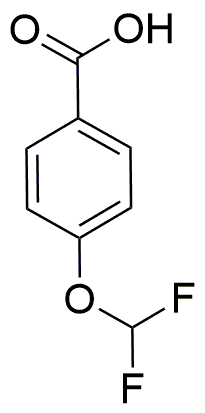4-(Difluoromethoxy)benzoic acid is widely utilized in research focused on:
- Pharmaceutical Development: This compound serves as a key intermediate in the synthesis of various pharmaceuticals, particularly in creating anti-inflammatory and analgesic drugs. Its unique structure enhances the efficacy of active pharmaceutical ingredients.
- Agricultural Chemicals: It is used in the formulation of herbicides and pesticides, providing effective solutions for weed management in crops. The difluoromethoxy group improves the compound's stability and activity against target pests.
- Material Science: The compound is explored for its potential in developing advanced materials, such as polymers and coatings, that require specific chemical properties for enhanced durability and performance.
- Research in Organic Synthesis: It acts as a versatile building block in organic synthesis, allowing chemists to create complex molecules with precision. This application is crucial for researchers developing new chemical entities.
- Analytical Chemistry: The compound is utilized as a standard in analytical methods, aiding in the detection and quantification of related substances in various samples, ensuring quality control in manufacturing processes.
General Information
Properties
Safety and Regulations
Applications
4-(Difluoromethoxy)benzoic acid is widely utilized in research focused on:
- Pharmaceutical Development: This compound serves as a key intermediate in the synthesis of various pharmaceuticals, particularly in creating anti-inflammatory and analgesic drugs. Its unique structure enhances the efficacy of active pharmaceutical ingredients.
- Agricultural Chemicals: It is used in the formulation of herbicides and pesticides, providing effective solutions for weed management in crops. The difluoromethoxy group improves the compound's stability and activity against target pests.
- Material Science: The compound is explored for its potential in developing advanced materials, such as polymers and coatings, that require specific chemical properties for enhanced durability and performance.
- Research in Organic Synthesis: It acts as a versatile building block in organic synthesis, allowing chemists to create complex molecules with precision. This application is crucial for researchers developing new chemical entities.
- Analytical Chemistry: The compound is utilized as a standard in analytical methods, aiding in the detection and quantification of related substances in various samples, ensuring quality control in manufacturing processes.
Documents
Safety Data Sheets (SDS)
The SDS provides comprehensive safety information on handling, storage, and disposal of the product.
Product Specification (PS)
The PS provides a comprehensive breakdown of the product’s properties, including chemical composition, physical state, purity, and storage requirements. It also details acceptable quality ranges and the product's intended applications.
Certificates of Analysis (COA)
Search for Certificates of Analysis (COA) by entering the products Lot Number. Lot and Batch Numbers can be found on a product’s label following the words ‘Lot’ or ‘Batch’.
Número de catálogo
Número de lote/lote
Certificates Of Origin (COO)
This COO confirms the country where the product was manufactured, and also details the materials and components used in it and whether it is derived from natural, synthetic, or other specific sources. This certificate may be required for customs, trade, and regulatory compliance.
Número de catálogo
Número de lote/lote
Safety Data Sheets (SDS)
The SDS provides comprehensive safety information on handling, storage, and disposal of the product.
DownloadProduct Specification (PS)
The PS provides a comprehensive breakdown of the product’s properties, including chemical composition, physical state, purity, and storage requirements. It also details acceptable quality ranges and the product's intended applications.
DownloadCertificates of Analysis (COA)
Search for Certificates of Analysis (COA) by entering the products Lot Number. Lot and Batch Numbers can be found on a product’s label following the words ‘Lot’ or ‘Batch’.
Número de catálogo
Número de lote/lote
Certificates Of Origin (COO)
This COO confirms the country where the product was manufactured, and also details the materials and components used in it and whether it is derived from natural, synthetic, or other specific sources. This certificate may be required for customs, trade, and regulatory compliance.


